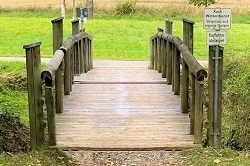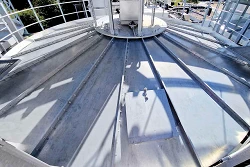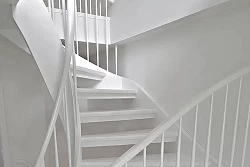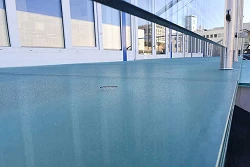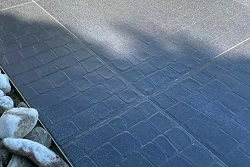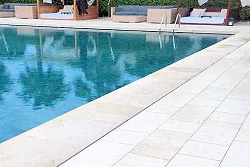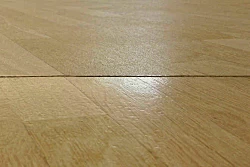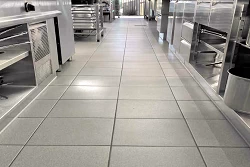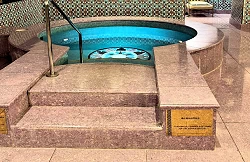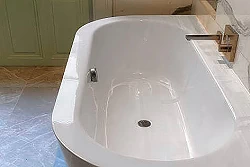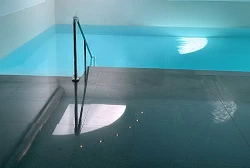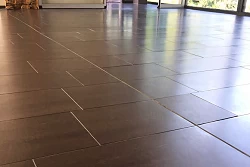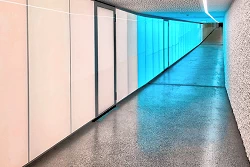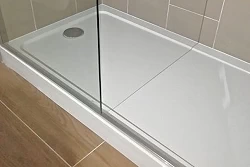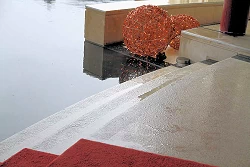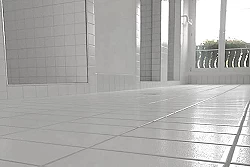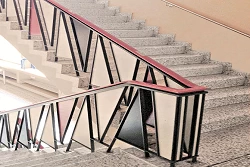Slip resistance - regulations and safety standards
GriP anti-slip is the world's only anti-slip coating that has been comprehensively tested and certified. Below you will find testing methodes and standards on slip resistance for the DACH countries. Furthermore for Australia, which has the world's highest requirement for slip resistance for pedestrian surfaces.

- Testing: Pendulum vs inclined plane
- Slip resistance locations
- Slip resistance of floor coverings in Germany
- Slip resistance of floor coverings in Switzerland
- Slip resistance of floor coverings in Austria
- Slip resistance of floor coverings in Australia
Testing: Pendulum vs inclined plane
Pendulum test to determine slip resistance and test on inclined plane are not considered comparable. While the pendulum tests are tests with calibrated equipment, the classification of slip resistance on inclined planes is performed by individuals with different characteristics (height, body weight, footwear, fitness). A comparison of the two classifications is therefore not possible. Consequently, the comparative values given here are cited in the technical literature exclusively as values for locations.
| Locations (selection) | Pendulum Test: Wet | Inclined plane: Oil-wet |
|---|---|---|
Pavements and ramps, outdoor |
P5 | R12 |
| Walkways and ramps, outdoor Exterior slope angle < 1:14 Balconies, terraces, walkways, crossings, markets, car parks |
P4 | R11 |
| Hotels, offices, public buildings, schools, day-care centers Wet areas, toilets Walkways |
|
R10 R9 |
| Supermarkets and shopping centers | P3 | R10 |
| Loading docks, commercial kitchens Cold storage rooms, bar areas |
P5 P4 |
R12 R11 |
| Swimming pools and sports facilities Pool ramps and stairs leading into the water Pool surrounds and shower rooms |
P5 P4 |
C B |
Additional information on SRT pendulum tests for measuring slip resistance.
Slip resistance of floor coverings in Germany
- DIN-Standards
- DIN 51130 (Engine oil with safety shoes on sloping surfaces)
- DIN 51131 (friction coefficient measuring devices)
- DIN 51097 (wet barefoot areas on sloping surfaces)
DIN 51097 Slip resistance values / slip resistance classes - wet barefoot areas:
| Assessment group | Angle of inclination | |
|---|---|---|
| A | 12° minimum angle | |
| B | 18° minimum angle | |
| C | 24° minimum angle |
DIN 51130 Slip resistance values / slip resistance classes R-value: working areas with footwear:
| Rating group |
Angle of inclination | Application | |
|---|---|---|---|
| R9 | from 6° to 10° | Indoor floor coverings, e.g. offices. | |
| R10 | >10° – 19° | Floor coverings e.g. public toilets. | |
| R11 | >19° – 27° | Commercial entrances and outdoor stairs. Commercial kitchens in child care centers, nursing homes, sanatoriums, etc. | |
| R12 | >27° – 35° | Industrial kitchens. | |
| R13 | >35° | Slaughterhouses. | |
- BGR 181 (previously ZH1/571)
Floors in workrooms and work areas with slip hazard.
Federation of Institutions for Statutory Accident Insurance and Prevention. BGZ Technical Committee "Structural Facilities", 2003. - Merkblatt 10
M 10: Floors in workrooms and work areas with slip hazards
Slip resistance of floor coverings in Switzerland:
- Beratungsstelle für Unfallverhütung
Swiss Council for Accident Prevention, bfu technical documentation 2.027, Floor coverings
Markus Buchser, Bern 2011
Slip resistance of floor coverings in Austria:
- ÖNORM EN 16165 - Determination of slip resistance of floors. 01.02.2022.
Walk-on surfaces:
EN ISO 868
ISO 48-2
ISO 48-4
ISO 5725-2
ISO 5725-5 - ÖNORM EN 16165 - European standard DIN EN 16165 "Determination of slip resistance of floors - Method of determination".
- ÖNORM Z 1261 - 01.08.2022 withdrawn.
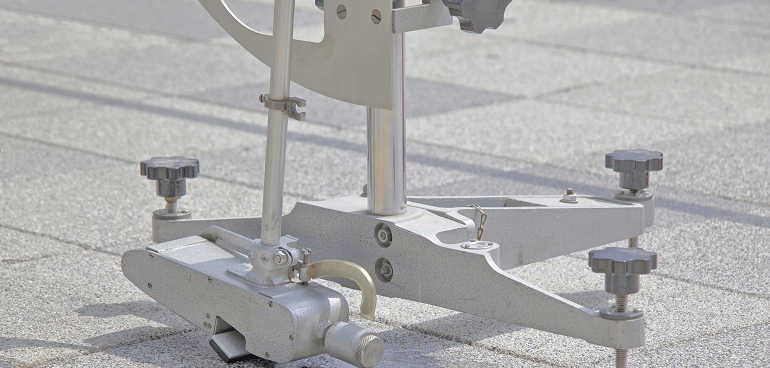
Slip resistance of floor coverings in Australia:
The Australian guidelines have been the world's most detailed and demanding standards for slip resistance of wet surfaces for pedestrians since 1999. The requirements have also been adopted by industries and companies outside Australia, such as cruise lines.
- HB 198 Guidelines to the Specification and Testing of Slip Resistance of Pedestrian Surfaces was developed by the Australian Standards Committee BD-094, Slip Resistance of Flooring Surfaces. Manual 198 was published in 2014.
Classification of floor coverings for pedestrian surfaces according to AS 4586-2013 Wet Pendulum Test: Wet Pendulum SRT Value (Slip Resistance Value).
| Slip Resistance Value | ||
|---|---|---|
| Classification | Slider 96 - Footwear | Slider 55 - Barefoot |
| P5 | >54 | >44 |
| P4 | 45–54 | 40–44 |
| P3 | 35–44 | 35–39 |
| P2 | 25–34 | 20–34 |
| P1 | 12–24 | <20 |
| P0 | <12 | |
Slip Protection
Contact us for a free quote or consultation:
